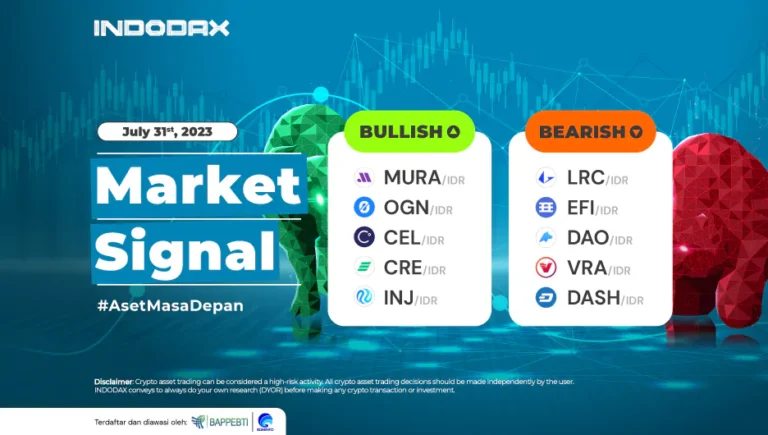In conversations in the economic field, many terms often appear and are important to know, one of which is fluctuation. This term refers to erratic changes in the price of a product/asset over time.
Fluctuations are one of the common phenomena in the financial market, namely when there are rising and falling prices of stocks, currency and foreign exchange, commodities, crypto assets, and so on.
Meanwhile, fluctuations in crypto prices refer to significant and often rapid changes in the value of cryptocurrencies, for example, Bitcoin, Ethereum, or other altcoins.
As is known, the crypto market is famous for its high volatility because prices can rise or fall dramatically in a short time. Dealing with fluctuations in crypto prices is also very important because it can be a source of high risk. Besides that, it is also important for the sustainability of the crypto market in general.
So, to better understand fluctuations, the causal factors, types, examples, and strategies for dealing with them, consider the following review.
What is Fluctuation?

According to the Big Indonesian Dictionary (KBBI), fluctuation is a symptom that shows price fluctuations. These price changes are due to the market’s influence on demand and supply.
In general, price fluctuations refer to changes in the price of a product, asset, or service from time to time. This phenomenon naturally occurs in the market and economy, which affects various sectors and industries.
Meanwhile, as discussed earlier, fluctuations in crypto prices refer to significant and often fast price changes in crypto assets, for example, in Bitcoin, Ethereum, Litecoin, and others.
The crypto market tends to be volatile due to several things, including its relatively small market capitalization, still depending on market sentiment and news, high uncertainty, and risk, and being influenced by speculation.
Factors Causing Fluctuations
After knowing the definition, now is the time to understand the factors that cause fluctuations. This is important to help market participants, analysts, and policymakers understand and anticipate economic and financial market changes.
Not only that but understanding these factors will also help in making better investment decisions and more effective risk management. The following are several factors that cause fluctuations that need to be known, including:
1. Economic conditions
The economic conditions of a country strongly influence price fluctuations. External factors, such as natural disasters and wars, can influence this economic condition.
In addition, this economic condition is also influenced by internal factors, including the number of unemployed, income levels, and so on. A stable economic condition in a country will reduce the possibility of price fluctuations.
2. International transactions
As is known, in transactions between countries, such as export-import, debt, and investment, there will be a flow of funds coming in or out. It also affects the rise and fall of prices.
3. Government policies
As for running a country’s economy, the government certainly has several fiscal and monetary policies. The policies regulated by the government can control economic fluctuations, especially when the currency experiences inflation or an economic crisis.
4. Requests and offers
Remember that the amount of demand and supply for an item will make the price of that item go up or down.
The number of requests and offers can be related to expectations and speculation about an item. For example, if there is speculation that an item is scarce, the price will rise.
5. Expectations and Speculations
Expectations on price values can also impact the level of fluctuation. In addition, expectations also determine estimates and speculations on price values.
Types of Fluctuations
Now you know what fluctuations are and the factors that cause fluctuations. Furthermore, it is also important to understand the different types of fluctuations.
Knowing these fluctuations is very important because it can provide deeper insight into the nature and impact of changes occurring in various economic sectors and indicators. The following are the types of fluctuations that need to be known, including:
1. Daily Fluctuations
Daily fluctuations refer to price changes that occur within one trading day. In this case, the price can increase/decrease significantly quickly.
2. Short-Term Fluctuations: Price changes over days or weeks
Short-term fluctuations include price changes that occur in a few days/weeks. Economic news, special events, and more can cause this fluctuation.
3. Long Term Fluctuations
Long-term fluctuations involve price changes that occur over months/years. Several factors, including economic conditions, industry trends, and government policies, can influence long-term price fluctuations.
4. Seasonal Fluctuations
Seasonal fluctuations are related to several products/assets that experience price changes related to certain cycles in a year. Examples include the tourism or agriculture industries when prices rise during the holiday or harvest season.
5. Fluctuations Regarding Global Markets
In this type of fluctuation, price changes can be influenced by global market conditions. Influential factors include changes in interest rates, geopolitical events, international trade policies, or currency fluctuations.
Fluctuation Example
After knowing the causal factors to the types of fluctuations, it is also important to know examples of fluctuations that have occurred.
By understanding examples, you will better understand the complexity and dynamics of the economy and how various factors can interact to cause changes in various sectors and indicators. Here are some examples of fluctuations that you need to be aware of, including:
1. Bitcoin Price Surge in 2017
Please note the price of Bitcoin experienced a spectacular spike in 2017. The contributing factors include increased investor interest and participation, increased media attention, and high market speculation.
In this case, the huge demand and the limited supply of Bitcoin caused the price of BTC to rise rapidly. However, the price spike was followed by a significant correction in the end. This happened because the market experienced excess speculation as well as regulatory concerns.
2. Declining Market Price of All Cryptos in 2018
2018 the crypto market experienced a significant decline after a price spike in the previous year or 2017.
Factors playing into this include fears of tighter regulation, an increase in the number of scams and accidents in crypto projects, as well as concerns about slower-than-expected adoption.
Not only that, government and central bank policies also influence market sentiment. In this regard, several countries impose restrictions or bans on cryptocurrencies.
3. Ethereum Price Increase during the “DeFi Boom” in 2020
The price of Ethereum in 2020 has experienced a significant increase. This is related to the DeFi (Decentralized Finance) boom.
DeFi refers to financial applications built on the Ethereum blockchain that make financial transactions and services possible without intermediaries.
The high interest and participation in DeFi projects have fueled a high demand for Ethereum as an asset in this ecosystem. The increased demand then led to a sharp increase in prices.
On the other hand, boosted by the general trend of the crypto market and the positive sentiment towards blockchain technology and crypto assets also contributed to the increase in the price of Ethereum during this period.
Strategies for Overcoming Fluctuations

Do you already know what examples of fluctuations have occurred? Now, it’s time to find a strategy for dealing with fluctuations. Overcoming fluctuations requires the right approach and strategy in various business, investment, and policy aspects.
By implementing the right strategy, companies and individuals can reduce fluctuations’ impact and better deal with economic changes. The following are several strategies for dealing with fluctuations that need to be known, including:
1. Maintain Stable Economic Conditions
The first strategy is to maintain the stability of economic conditions. Internal factors and external factors can influence economic conditions. In addition, the social condition of a country will also greatly affect economic conditions.
2. Making Policies by Economic Conditions
The birth of appropriate policies can also help create a more conducive economic climate. Take, for example, increasing exports and reducing imports applied in a country.
Apart from that, you can also change regulations to invite more investors to invest in a country.
3. Plan the number of offers and requests
Regulating the amount of demand and supply for an item can be a control strategy that can be implemented when the price rises. Of course, this is done by planning the amount of supply and demand according to the analysis and careful calculation related to market conditions.
4. Maintain Currency Value
Safeguarding currency values by converting some crypto assets to fiat currency (such as USD) when prices are rising and then converting them back into crypto assets when prices are falling will help protect the value of assets from sharp price fluctuations.
5. Strategy of Averaging Dollar Cost (DCA)
Averaging Dollar Cost (DCA) means buying a fixed amount of crypto assets at regular intervals regardless of price fluctuations. Buying a fixed amount over time will give investors an average purchase price that can reduce the impact of short-term price fluctuations.
6. Portfolio Diversification
Diversifying your crypto portfolio by investing in different types of crypto assets can also reduce the risks associated with single price fluctuations. By owning several different assets, the potential loss of one asset can be offset by better performance than another.
7. In-Depth Research and Analysis
Conducting in-depth research and analysis of the crypto assets of interest is also important for reducing risk and dealing with price fluctuations. Understanding project fundamentals, development teams, industry adoption, and technology development can help make better investment decisions.
Conclusion
In conclusion, dealing with fluctuations in crypto prices is also very important because they can be a source of high risk. Besides that, it is also important for the sustainability of the crypto market in general.
Furthermore, overcoming fluctuations requires the right approach and strategy in various business, investment, and policy aspects. By implementing the right strategy, companies and individuals can reduce fluctuations’ impact and better deal with economic changes.
Please note that managing risk wisely is important to dealing better with price fluctuations. Protecting your investment capital from significant losses due to sharp price fluctuations is important.
Besides that, it is also useful for maintaining emotional stability and avoiding overreaction to price fluctuations. Furthermore, it is also important to avoid large losses and increase the chances of success.
After understanding fluctuations, the causal factors, types, examples, and strategies for dealing with them, now is the time to start investing in crypto on the best crypto trading platform, INDODAX.
You also need to know that currently, INDODAX has the INDODAX Earn/crypto staking feature, which can be accessed easily. However, previously you could download the best crypto trading application.
In the INDODAX Earn/crypto staking feature, you can lock up your crypto assets like funds in a deposit. The locked crypto assets will later generate rewards like interest on savings. Interesting right?
Happy investing!








